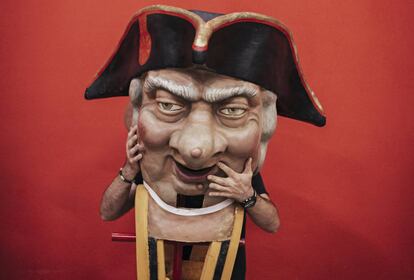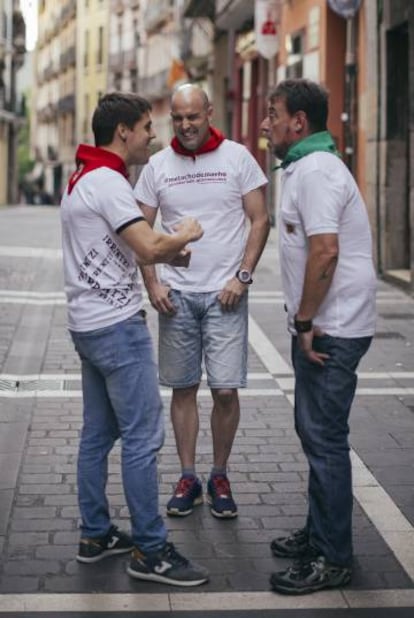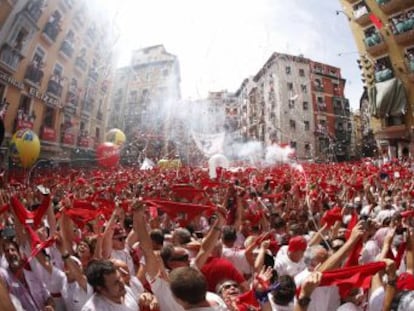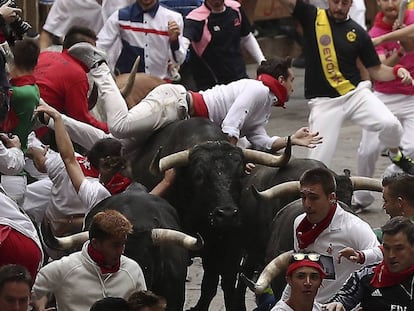Sanfermines: The best fiestas in the world
On July 6, a rocket known as the chupinazo kicked off the mother of all Spanish fiestas. A million people from all over the planet come to Pamplona every year for the Sanfermines, an orgy of sound and color that lasts nine days and nights, and where no one is looking at their watch. This year San Fermín is looking to catch its breath in the wake of ‘La Manada’ sexual assault case. Here is how the biggest party in the world gets going

There they are, the symbols of San Fermín, reborn each year in a sea of red and white, in the rituals of the month of July. The fighting bull, the saints in the chapel, dancing until dawn and one-night stands; the breaking down of social barriers, the processions of “giants” and “big-heads,” the churros on Mañueta street, the excited children, the hotel rooms at €1,000 a night, wine and champagne, the sweet smell of sweat, bodies packed in the Pamplona streets… Every year this city reaches a state of ecstasy, because, as the older folks used to sing: “It won’t be long to wait for the glorious San Fermín.” The biggest party in the world.
On Friday, July 6, the chupinazo rocket was fired into the sky of Pamplona, marking nine days when attendees can forget about the rest of the world. As always, Sanfermines are a tribute to hedonism. But this year’s edition is the post-“La Manada” San Fermín – the court case that saw five men convicted for escorting an 18-year-old into a residential building at the 2016 edition, and sexually assaulting her. The case has, without a doubt, taken its toll on the fiestas. But the reaction has sparked pride among the men and women of Pamplona. As the regional premier of Navarre, Uxue Barkos, explains: “Some have tried to degrade Sanfermines by portraying them as a non-stop bacchanal, something they never were. Here, when La Manada episode happened, nobody was held back, especially younger people, who put a stop to the partying and took to the streets to protest. As such, I think Pamplona should serve as a benchmark for Spanish society at large.” Shortly afterwards, in a more relaxed tone while opening the door to the Council Hall, the premier chuckles as she comments: “The Navarre government continues its work during San Fermín in the midst of all the chaos, so I have had to meet my councilors in this room, all of us dressed in red and white! Madre mía, if anyone ever got a photo of that…”
La Manada has, without a doubt, taken its toll on the fiestas. But the reaction has sparked pride among the men and women of Pamplona
The mayor of Pamplona, Joseba Asirón, also weighs in on La Manada case and its possible interpretations. “Sexist attacks are not specifically a problem in Pamplona,” he says from his office in City Hall. “Things like that have happened here and at the Pilar [fiestas in Zaragoza], at the Semana Grande in Bilbao, at the Feria de Abril [in Seville], only they weren’t reported. There was a shroud of silence. There was a positive mix in Pamplona: a woman who was willing to report what happened, citizens who took to the streets and a city council that rose to the challenge posed by civilian demands.”

Chaos. That’s something that Amaia de Esteban knows about. She’s in charge of protocol at Pamplona City Hall, and she is the person who, year after year, handles the myriad requests to watch the chupinazo live. Around 300 people gather every July 6 in the rooms of the City Hall that open up to the balconies overlooking the Plaza del Ayuntamiento. In other words, to the jungle. “Men and women of Pamplona, long live San Fermín!” goes the cry when the chupinazo is lit. A roar rises up from the throats of the thousands of people who arrive from all over the world. The txistularis (pipers) and other musicians from the municipal band, La Pamplonesa, play the Biribilketa of Gaínza or the Waltz of Astrain.
La Pamplonesa provides the soundtrack of San Fermín – day and night. At the bullfights and in the dianas, a kind of musical wake-up call that passes through the streets. Its president, José Andrés Palacios, who plays the clarinet, sees Sanfermines as the 10 best and worst days of the year: “They are hard, stressful times, with physical and psychological wear and tear, because we spend the entire day playing music – not exactly in a concert hall but rather surrounded by a huge mass of people who are partying in the streets. Being from Pamplona, however, we’re very appreciative of it.”

Pamplona during San Fermín is in a constant state of shock. “Sanfermines tests the very foundations of the city,” explains Joseba Asirón of the Basque nationalist Bildu party, and mayor of the city since June 2015. “You can’t bottle the essence of these festivities. The city is designed for 200,000 people and these days it receives a million… a million people out on the streets all day long!”
The origins of Sanfermines have been somewhat lost in the mists of time, and even though there is talk of farming and husbandry fairs from the Middle Ages, bullfights in the 16th century, religious services from the 13th century and the glory of Saint Fermín of Amiens, there is not much of an academic basis for all of these legends. Asirón, a doctor of history and a specialist in medieval Navarre, prefers to discuss the more recent past: “Up until 1915, Pamplona was a town of priests and soldiers surrounded by walls and unable to grow, with strict social mores and censorship, where people needed an escape valve, to the point that the priests and soldiers even saw that it was good to let people let loose now and then.”
Today’s Sanfermines unleash both the traditional festive rituals, but also a social commitment in attendees. Also let loose every year is the business side of the event. Mikel Ollo, partner in a company called Destino Navarra, is a tourist guide who rents balconies where people can watch the encierros, as the bull runs are known. In 2017 he handled around a thousand front-row places, “at a price of €140 per person per day.” The spectacle of watching the bulls running by can last about four seconds, “but the shot of adrenalin is terrific,” he explains. Mikel Ollo handles 17 balconies. There are two options: with a guide or with the owner, both with breakfast included. This entrepreneur is already working on the 2019 Sanfermines. The goal is to accommodate a group of 100 Australian businessmen. “The budget is not an issue for them. In fact, there are quite a few visitors who can spend more than €1,000 a day at San Fermín. What for some represents a monthly wage, they spend in a single day,” he says with a chuckle.
There are quite a few visitors who can spend more than €1,000 a day at San Fermín. What for some represents a monthly wage, they spend in a single day
Since Friday, Mikel Ollo has been shepherding 300 visitors from China onto balconies in Pamplona. One of them requested a private balcony for himself, his wife and his four children. “I only have one private balcony, but it’s for 15 people, and you would have to pay for 15 places,” warned the seller. “Perfect,” replied the buyer. A US film producer and his family rented through him the entire balcony of a hotel with a view of the encierro. “Last year a Russian who turned 50 came along with 50 friends he had invited. He wanted everything on an exclusive basis. We even had to arrange a flamenco concert at the hotel.”
Ollo, however, is aware that something is amiss. “At Pamplona we think we’re really cool and that the Sanfermines sell themselves, like they did in the old days, but it’s not that way at all. Increasingly you have to come up with novel offers.” In effect, hotel occupancy for the festivities in 2017 was at 82%, quite a distance from the legendary “NO VACANCY” sign that used to be regularly hung out. Ahead of this year’s event there were still quite a few rooms available for the second half of the week.
The 16 Pamplona peñas – cultural and sports associations, with around 5,000 members in total – are, among other things, the great protagonists of the bacchanal that turns the bullring on Paseo de Hemingway into an unparalleled place. Many of the members of the peñas turn their backs on the action going on in the ring. Those for and against bullfighting come together in the afternoon amid laughter, dancing, music, petty quarrels and loads of fun.

Do the peñas in Pamplona favor bullfighting? Are they against it? “There are people of every inclination, those who are for and those who are against bullfighting, as well as people from all the different political parties,” says Patxi Osés, from La Única peña. Imanol Azcona, from Irrintzi, presides over the Federation of Peñas of Pamplona. His analysis of the fiesta is crystal-clear: “San Fermín is organized disarray.”
None of this would be possible without the huge clean-up operation that, day and night, tidies up the apocalypse left behind by the public. Its coordinator is Iñaki Apeztegia, for whom the most difficult task is keeping Estafeta Street clean for the bull runs. At 4am, with this popular zone of the old quarter of Pamplona still in a trance, the cleaning team puts in a garbage collecting truck that needs protection from the municipal and regional police due to the volume of revelers. New industrial cleaning products and working protocols have slowly but surely managed to curb and counter the traditional, sticky and wretched-smelling film left behind by the alcoholic beverages, urine and bits of food that customarily accumulate on the streets. It’s an achievement of legendary proportions. The 250 cleaning workers remove around a thousand tons of garbage during the fiestas.
One of the focal points of the fiestas lies in San Gregorio and San Nicolás streets, two of the major arteries in the old quarter. At the corner of San Gregorio and Ciudadela is Anaitasuna, one of the best-known bars in town. Sadly, the Anaita will be living its last Sanfermines this year. This business, run by the Seminario family, will close next July 15 after 38 years of uninterrupted activity. The maelstrom of San Fermín is likewise present at the premises of Hotel Europa, on Espoz y Mina, between Plaza del Castillo and the bullring. There, the Idoate family run a quaint little hotel and restaurant with a Michelin Star.

Juan Mari Idoate, vice-president of the Association of Hotel and Restaurant Entrepreneurs and member of the Navarre Tourism Board, defines himself as “crazy about Sanfermines.” However, he does not see everything in a rosy light: “We lack a strategy. There are warning lights flickering – for example, unfair competition. The city council can’t sit by while all of a sudden, every July 5, 15 street stands suddenly open up to sell 500 crates of Coke and 1,000 baguettes.”
More than 50 people work long and hard at the Europa. Being an upscale hotel, it is somewhat like an inn during the Sanfermines. “The things people feel at these fiestas is unique. I know a neurologist who tells me he’d like to do tests on people at San Fermín to find out what they are going through…,” says Juan Mari Idoate.
San Fermín without bullfights is unthinkable, and it seems impossible that the mayor of the city should question their continuity during the fiestas. No bullfights, no Running of the Bulls. No Running of the Bulls, no Sanfermines. Even if, as is the case right now, the Pamplona mayor belongs to a political party such as Bildu, which is openly opposed to bullfighting. “I am pro-bullfighting eight days a year, and the rest of the year I would never go to a bullfight. And if anyone expected Pamplona to have a mayor without contradictions, with Joseba Asirón they got it all wrong,” explains the mayor. A few days after he said this, Asirón made further statements and admitted: “The discussion regarding bullfights will have to be addressed someday.” He added: “I can’t imagine Sanfermines without the Running of the Bulls, but they could get by without the bullfights.” He stopped short of talk of eliminating them in the near term.
During Sanfermines, the Pamplona bullring becomes a Roman circus. Witness of this is Antonio Izquierdo, the caretaker of the bullring, who lives year-round in a small house located in the horses’ courtyard of the bullring with his wife, his three daughters and his dog. It’s a little house in central Pamplona, removed from the world, white-washed and with flowers. “In San Fermín there are 300 people working here from 4.30am to 1am. You lack a life of your own: police, loudspeaker technicians, cleaning services, stockbreeders, guests, journalists… It goes on round the clock.”
I can’t imagine Sanfermines without the Running of the Bulls, but they could get by without the bullfights The mayor of Pamplona, Joseba Asirón
A change of scenery. For those who yearn for crisp, luxurious white sheets in which to briefly escape the nine days of chaos, there is only one place to be: the Gran Hotel La Perla, on the corner of the emblematic Plaza del Castillo. Whoever wants to spend Sanfermines at this old hostel, which has been redesigned as a five-star hotel (and boasts a previous guest list including the likes of Sarasate, Manolete, Hemingway, Belmonte and Woody Allen) can still get a room. A thousand euros is the fare paid by those wishing to watch the encierro from their lodgings. Pamplona-born Fernando Hualde is the receptionist at La Perla. He has been working here for 41 years (he started out as a bellboy when he was 15). “Here we pay attention to detail,” he explains in a quaint little hall of this hotel, which seems to be rooted in the past. “So you may come across a gentleman who asks you for a PlayStation for his son, and you have no choice but to find one. Or another one who reserves two rooms and asks for one of them to be fitted out as a gym. So you go to a gym, rent some weights and other devices, remove the furniture from the room and set up the gym. It’s hard to do this right during the fiestas but you get it done. Nobody said it was easy.”
This extremely polished professional abounds with anecdotes of some of their foreign guests: “For instance, an American who wears the red neckerchief of San Fermín 365 days a year back home, or a South African family who have part of the wooden fences from the encierro dividing their living room.”
A five-star hotel right in the middle of the San Fermín madness? Clearly Pamplona, from July 6 to 15, requires that you be open to everything. Everything means everything, according to the key master of La Perla: “Even though we have a person who screens who comes in, this is a place where all sorts of characters may show up. So if a tipsy gent comes in saying he wants to sell you a submarine, you don’t tell him to get lost. It’s wiser to discuss the color of the submarine, so he ends up saying, ‘Christ, this guy’s in a worse condition than I am.”
Every morning, at the encierro, 55% of those taking the plunge are running for the first time, meaning that danger is ever present
As far as screening goes, the true expert is Xabier Ibáñez, director of civilian security and coordinator of a unit comprising the Municipal Police, the regional police, the Civil Guard, the National Police, Civilian Protection, the fire service, out-of-hospital emergencies, the Red Cross and DYA automobile assistance. “The main difficulty is cleaning the route of the encierro. In the end we more or less limit how many people we want to run. First we target those who are not in the right condition: runners with backpacks, those who are barefoot, drunk, carrying video cameras… And then if we think there are too many people we try to clear the route because otherwise the encierro could end up blocked,” says the ultimate policeman of Sanfermines, who also mentions that the terrorist threat remains present: “We have a level-four jihadist terror threat. We must thoroughly protect the most crowded events at the fiesta: the chupinazo, the processions, the fireworks, for which around 50,000 people can gather….”
It’s 8pm in Pamplona and Miguel Araiz, known as Rastrojo, is at the Corrales de Santo Domingo, the stockyards. For 45 years, and up until last year, he was a herdsman at the encierros. Highly respected, he is small and strong, with stone hands, a number of scars along his body and a rugged, concise discourse – someone from another age. His time to relax has arrived, after four-and-a-half decades acting as the guardian angel of the runners, always with a long stick in his hand. He has smacked the hind quarters of bulls and the backs of novice runners – not to mention anyone acting like a moron. Every morning, at the encierro, 55% of those taking the plunge are running for the first time, meaning that danger is ever present. “I never regretted hitting anyone,” he says. “If it weren’t for this long stick… I for one would rather get hit by Rastrojo than be gored by a bull.” At 67 years of age he looks great and is in very good shape: “I always ate what my mother or my wife cooked for me. Never been a drinker. Never been a smoker. Never gone with bad women.”
But there is more to the fiesta than the bulls, the food and drink, and the all-night partying. During the day Sanfermines are calmer, suited for families, geared to entertaining the little ones. In this part of the world, the absolute stars are the kilikis and giants of Pamplona, an obsession for kids during San Fermín. Mari Ganuza has been conserving and caring for these huge puppet figures for 41 years. They go back a century and a half. Although very few know it, Caravinagre, Verrugas and El Patata (Vinegar-face, Warts and The Potato) spend most of the year at rest in a huge, surreal warehouse in the basement of the city’s bus station. These huge cardboard and papier-mâché figures are deliciously outdated, terrifying and full of charm.
What do runners in the encierro have to say about all this? Fermín Barón, going by the nickname “Pitu,” has run in front of the bulls for the last 30 years. Now he is enjoying a beer on Estafeta Street, but all the blows, falls and scares are something he always has present. Over the years, his view of the encierro has shed its romantic aura: “It has lost its essence. There was a time when you could get in front of a bull every day, but today it’s all a mass stampede. People no longer come here to run but to compete.”
—Do you feel nostalgia when you think of those encierros that no longer exist?
—Of course. But look, I feel like part of a tribe. When I run in front of the bulls, I feel like the last of the Mohicans.
Pitu is not one of those runners who has found some kind of divine experience that some have sought by running with the bulls. “I’m 48 and have been running for the last 30 years, but it’s really not such a big deal. Television has been quite harmful. In the end, the encierro is just another event at Sanfermines. You don’t have to be some kind of veteran from the war in Afghanistan. Anyone can run.”

San Fermín is infinite. It contains nearly everything. You have a charming lady such as Mariví Esparza, who takes the statue of San Fermín every morning from the City Hall to the niche in Santo Domingo, where the runners sing for his protection (the rest of the year she keeps it in her living room). The religious icon was purchased by three runners in 1978, among whom was her husband, Andoni Barba, who died in 1993. They bought it in a shop selling religious articles in Pamplona to replace the saint that was put there each year by the nuns from the Military Hospital, which was lost. “I get really excited taking it there every morning, but at the same time I have mixed feelings,” she admits.
And you have Paulina Fernández, smiling and elegant at the ripe old age of 96, and her family, the Elizaldes, her children, grandchildren, nephews and nieces, sons-in-law and daughters-in-law, once again raising the shutter of the churrería at Mañueta Street at 6am, a ritual that goes back 145 years. During San Fermín the family members cast away their year-round jobs as gynecologists, teachers, lawyers and engineers and roll up their sleeves to knead the dough and serve the best churros in the world every morning. The whole world fits in Pamplona, from July 6 to 15. Pure ecstasy. A blast of red neckerchiefs.


